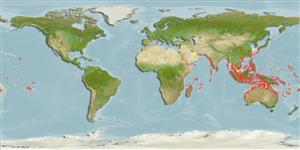Environment: milieu / climate zone / depth range / distribution range
Écologie
marin; eau douce; saumâtre démersal; catadrome (Ref. 46888); profondeur 10 - ? m (Ref. 40448). Tropical; 32°N - 35°S, 22°E - 136°W
Indo-Pacific: east coast of Africa, south to Eastern Cape in South Africa (Ref. 52193), including Madagascar, Seychelles, Rodriguez; north to Sri Lanka and India (except Bay of Bengal), Andaman and Nicobar Islands, east to Indonesia, China, the Philippines, Japan, Marshall and Tuamoto islands, Melanesia and Polynesia (Ref. 2830). Distribution includes the Red Sea (Ref. 84159) and Persian Gulf (Ref. 66734).
Length at first maturity / Taille / Poids / Âge
Maturity: Lm 23.0 range ? - ? cm
Max length : 60.0 cm SL mâle / non sexé; (Ref. 4967); common length : 26.0 cm SL mâle / non sexé; (Ref. 4967); âge max. reporté: 6 années (Ref. 127264)
Épines dorsales (Total): 4 - 5; Rayons mous dorsaux (Total): 8-9; Épines anales 3; Rayons mous anaux: 8 - 10.
Occur in shallow coastal waters, and from brackish water to freshwater regions of rivers (Ref. 41299). Form schools (Ref. 40448); in larger aggregations during spawning, which takes place at sea (Ref. 2830). Feed on small algae, diatoms, forams, benthic polychaetes, crustaceans, mollusks, organic matter and detritus; fry feed on copepods and floating algae (Ref. 40448). Oviparous, eggs are pelagic and non-adhesive (Ref. 205). Caught mainly during the spawning season and is sold fresh; the roe is highly appreciated.
Nakabo, T., 2002. Fishes of Japan with pictorial keys to the species, English edition I. Tokai University Press, Japan, pp v-866. (Ref. 41299)
Statut dans la liste rouge de l'IUCN (Ref. 130435)
Menace pour l'homme
Harmless
Utilisations par l'homme
Pêcheries: commercial; Aquaculture: commercial; pêche sportive: oui
Outils
Articles particuliers
Télécharger en XML
Sources Internet
Estimates based on models
Preferred temperature (Ref.
123201): 24.5 - 29, mean 28 °C (based on 810 cells).
Phylogenetic diversity index (Ref.
82804): PD
50 = 0.5078 [Uniqueness, from 0.5 = low to 2.0 = high].
Bayesian length-weight: a=0.01288 (0.01051 - 0.01579), b=2.93 (2.90 - 2.96), in cm total length, based on LWR estimates for this species (Ref.
93245).
Niveau trophique (Ref.
69278): 2.6 ±0.26 se; based on food items.
Résilience (Ref.
120179): Faible, temps minimum de doublement de population : 4,5 à 14 années (K=0.10).
Fishing Vulnerability (Ref.
59153): Moderate to high vulnerability (49 of 100).
Nutrients (Ref.
124155): Calcium = 138 [59, 322] mg/100g; Iron = 1.09 [0.51, 2.31] mg/100g; Protein = 18.3 [16.5, 20.0] %; Omega3 = 0.25 [0.12, 0.56] g/100g; Selenium = 38.3 [18.7, 89.9] μg/100g; VitaminA = 17.7 [4.8, 58.4] μg/100g; Zinc = 1.69 [1.14, 2.55] mg/100g (wet weight);
